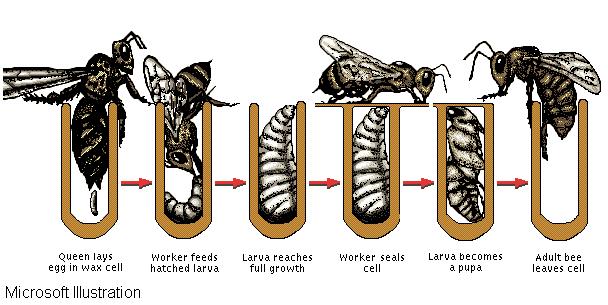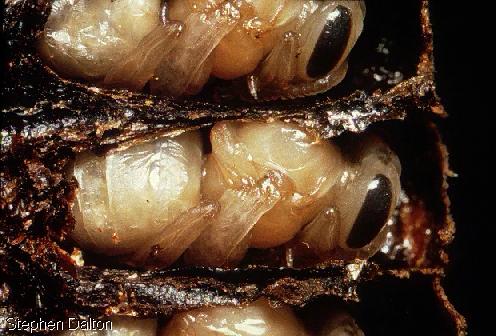Honey Bees

Characteristic Behavior of Bees
As they fly from flower to flower, worker honeybees collect pollen grains in a special “basket” located on the hind leg. Pollen, the
main food source for protein, vitamins, minerals, and fat, is necessary to the development of queen, worker, and drone. Field
bees place pollen directly in the cells of developing larvae when they return to the hive, where they also regurgitate nectar for its
conversion into honey.
Larry Crowhurst/Oxford Scientific Films
Bee Behavior, Microsoft® Encarta® 96 Encyclopedia. © 1993-1995 Microsoft Corporation. All rights
reserved.

Three Bees to a Colony
Worker bees (bottom, left), of which there are thousands, far outnumber the single queen (center) and hundreds of drones (top)
that belong to one hive. When foraging, worker bees suck water and nectar through the movable, flexible tubes of their
mouthparts and use their jaws for grasping wax and pollen. Bees have three simple eyes on the tops of their heads and one
large compound eye on either side. Their two sets of wings attach by a row of tiny hooks lining one edge of the front pair. Only
the queen, detailed here, shows ovarian development. She secretes several pheromones, one of which eliminates potential
rivals by inhibiting reproductive development in other females.
Microsoft Illustration
Three Bees to a Colony," Microsoft® Encarta® 96 Encyclopedia. © 1993-1995 Microsoft
Corporation. All rights reserved.

Development of the Honeybee
The queen honeybee may lay 1500 eggs in a single day. Worker bees feed the wormlike larva constantly—as many as 1300
times a day—after it hatches, sealing the cell when the grub has grown to fill it. The larva pupates in about 12 days, and the adult
bee chews through the wax cap of its cell approximately three weeks after the eggs were first laid. Newly emerged adults
perform various maintenance tasks until they are ready to begin foraging outside the hive.
Microsoft Illustration
Development of the Honeybee," Microsoft® Encarta® 96 Encyclopedia. © 1993-1995 Microsoft
Corporation. All rights reserved.

Bee Larvae Encased in a Cell in the Hive
Bee larvae are fed a combination of honey and pollen until they hatch. If during its larval stage a bee is fed royal jelly, a
specialized mouth secretion of the worker bees, it will become a queen.
Stephen Dalton/Photo Researchers, Inc.
Bee Larvae Encased in a Cell in the Hive," Microsoft® Encarta® 96 Encyclopedia. © 1993-1995
Microsoft Corporation. All rights reserved.
Cross-Pollination
Bumble bees and other insects perform the important function of cross-pollination as they move from flower to flower. Pushing
between the tightly closed petals of the toadflax flower to feed on the nectar within, this bee’s furry back picks up pollen from the
flower’s anthers. The bee will carry the pollen to the stigma of another flower, as shown here, depositing pollen collected at a
previous stop.
Cross-Pollination," Microsoft® Encarta® 96 Encyclopedia. © 1993-1995 Microsoft Corporation. All
rights reserved.
Back to Insect Index
Design by:
 Pagoda Vista
Pagoda Vista





